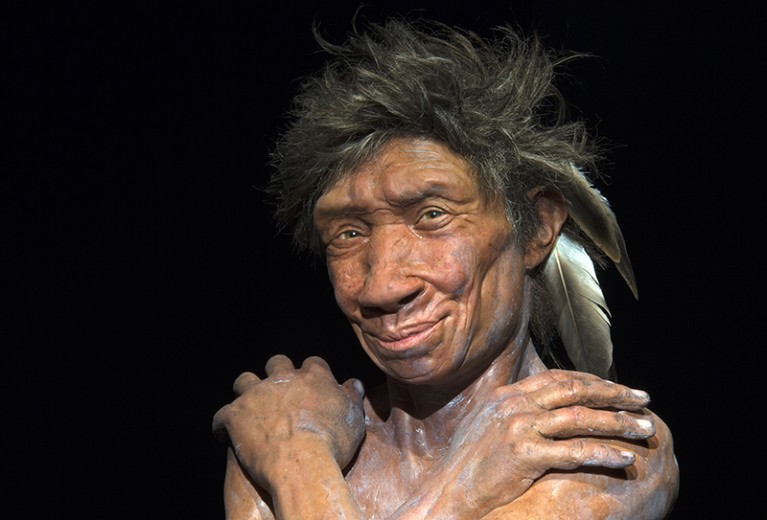
The Neanderthal woman nicknamed Nana, reconstructed at the Gibraltar Museum, with feathers.Credit: S. Finlayson/Gibraltar National Museum
The Smart Neanderthal: Bird Catching, Cave Art, and the Cognitive Revolution Clive Finlayson Oxford University Press (2019)
The stereotype of Neanderthals as uncreative and unintelligent is remarkably persistent. In The Smart Neanderthal, archaeologist Clive Finlayson challenges that view. His assessment is informed by archaeological evidence, including his own decades-long research on groups of Homo neanderthalensis that lived on and around the Rock of Gibraltar from 125,000 to just over 30,000 years ago. Intriguingly, birds form a significant part of his argument.
Finlayson, director of the Gibraltar Museum since 1991, takes aim at researchers who have interpreted the archaeological record of Neanderthals as suggesting that the species never attained the brain power of contemporary Homo sapiens. Sure, Neanderthals get marks for surviving at a time when the cold climate brought tundra conditions to most of Europe. But the conventional wisdom is that the modern humans who moved into Europe soon after leaving Africa some time in the past 50,000 to 70,000 years had already raised their cognitive game a notch or two, thus enabling them to prosper and eventually outwit their Neanderthal cousins.
Gibraltar lies at the southwestern edge of Neanderthals’ geographical range. Finlayson argues that discoveries his team has made at four main cave sites suggest that the species’ behavioural repertoire was more sophisticated than the popular caricature suggests. He says that the Neanderthals living there had access to, and took advantage of, a much wider range of resources than their northerly cousins, including rich avian biodiversity. And he posits that an archaeologist not familiar with animal behaviour would be unable to decipher the Gibraltar Neanderthals’ cognitive parity with modern humans.
The name of our closest extinct relative commemorates Joachim Neander, a seventeenth-century German poet who sought inspiration in the valley (Tal) of the river Düssel, which was given his name. In 1856, miners working in the valley exposed the partial skeleton of an adult human whose skull, despite once harbouring a brain much the same size as a modern human’s, lacked a forehead. Some speculated, bizarrely, that these were the remains of a modern human with rickets. In 1864, Irish geologist William King recognized them as belonging to a species of extinct human relative.
Since then, a comprehensive fossil record for H. neanderthalensis has been established from across Europe, Central Asia and the Middle East. Differences between modern-human and Neanderthal genomes suggest a common shared ancestor between 250,000 and 500,000 years ago, and evidence for interbreeding has emerged (T. King Nature 555, 307–308; 2018). Yet misinterpretations of fossils discovered in the early twentieth century led to the misconception that Neanderthals had a stooped posture, resulting in erroneous reconstructions that exaggerated their physical differences from us. The idea arose that if they looked different from us, they must have behaved differently. Until recently, a Neanderthal’s life was seen as “nasty, brutish and short”, to borrow philosopher Thomas Hobbes’s description of the natural human lifespan.
Gibraltar’s caves have provided rich pickings. In 1848, an adult cranium (retrospectively recognized as Neanderthal) was recovered from Forbes’ Quarry. From the 1860s, many vertebrate fossils, and stone tools of the type found with Neanderthal fossils across Europe, were recovered from the caves. And in 1926, the pioneering archaeologist Dorothy Garrod discovered a second Neanderthal fossil — a child’s cranium.
Finlayson, his wife Geraldine and son Stewart — both researchers — are passionate amateur birdwatchers, and the knowledge they have collectively amassed infuses his research on the Gibraltar fossils. In highlighting how our ancestors and close relatives interacted with birds, it reveals a long-neglected source of evidence about human and Neanderthal behaviour.
When Neanderthals occupied the Gibraltar caves, sea levels were lower. The hominins shared their habitat with a much wider variety of animals, particularly birds, than is seen today. Fragile bird bones survive well in the relatively protected atmospheres of caves, and the fossils recovered sample 160 avian species. That covers 30% of the avian species known from Europe for the time, ranging from the pine grosbeak (Pinicola enucleator, a finch), to ducks, choughs, larks, gannets, eagles and vultures. Finlayson suggests that tool marks left on the bones indicate that some of the species on Gibraltar were processed for food or, more controversially, for their feathers. He reminds us that birds come in many shapes and sizes, with a variety of behaviours and responses to humans, which implies that their exploitation would have required sophisticated knowledge. But he goes further, arguing that this knowledge was comparable to that drawn on by modern birders.
Not all of Finlayson’s inferences (including this one) are logically sound, and The Smart Neanderthal would have benefited from some editorial ‘tough love’. His point about the neglect of avian evidence is well taken, however. So is his reflection that most of the humdrum things we do daily do not necessarily reflect our cognitive potential. His findings from Gibraltar — with those by anthropologist Dirk Hoffmann and his colleagues suggesting that Neanderthals decorated the walls of three caves in Spain — might have exposed a cognitively advanced side of our Neanderthal cousins.
However, one swallow — or even a handful — does not make a summer. We need to find more sites in which Neanderthals were put through their behavioural paces.

 Human evolution: How we misread our own story
Human evolution: How we misread our own story
 Evolution: The human puzzle
Evolution: The human puzzle
 Neuroscience: Neanderthals in mind
Neuroscience: Neanderthals in mind








